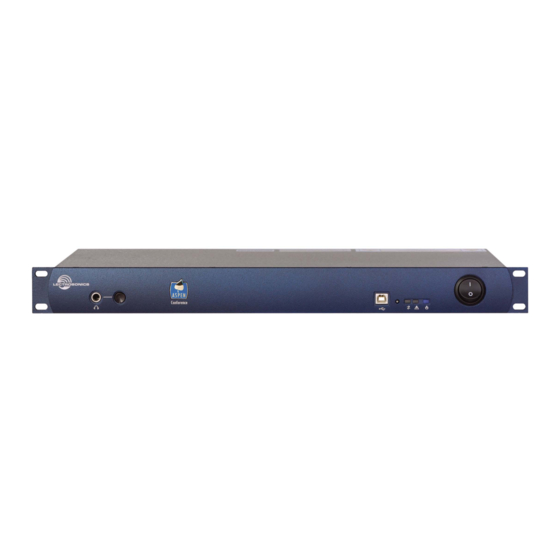Table of Contents
Advertisement
Quick Links
SPNCWB
Wideband Bridging Conference Interface
• Quad-reference Wideband Acoustic Echo
Canceller supporting 3-way Bridging
• Two maximum speed grade, 4th generation
SHARC
processors*
®
• Dual Codec interfaces
• TCP/IP Ethernet Addressable
The SPNCWB wideband conference interface makes
telepresence and multi-site bridging simple and effec-
tive in any conference room, with full bandwidth audio
frequency response and a unique Quad-reference AEC.
Each conference connection includes a dedicated AEC
for fast and reliable echo cancellation:
• Telephone line (POTS)
• Codec 1
• Codec 2
The fourth AEC is assignable to any final mix in the ma-
trix for purposes such as noise cancellation (when fed a
signal from a sampling microphone).
The AEC converges very fast and will remain converged
during double-talk and any signal type, including sine
waves, enabled by an advanced DSP algorithm. Cancel-
lation depth increases with even with brief signal peaks
from the far ends.
The AEC in combination with the patented proportional
gain mixing algorithm (
US Patents 5,414,776 and 5,402,500)
provides outstanding audio quality without echo heard at
the far ends. Signals from the far ends of the conference
are routed to the local sound system and to three mixes
that are used as reference signals by the AEC. Audio
from the local microphones (which includes far end audio
delivered by local loudspeakers) is routed to the AEC via
another final mix for cancellation of the far end signals.
After processing, the output of the AEC is routed back to
the far ends through the matrix.
* SHARC is a registered trademark of Analog Devices, Inc.
• Fully integrated with ASPEN digital matrix
• Adaptive Proportional Gain Automatic
Mixing at the Matrix Crosspoints
• Third Octave Noise Filter on each channel
• Sigma-delta class-D audio power amplifiers
Three remote sites can be bridged with a local sound
system for a seamless telepresence or audio conference.
The far end audio signals participate in the same man-
ner as local microphones connected to the mixer.
A full complement of audio signal processing is provided
for all inputs and outputs. In addition, a proprietary NRF
(noise reduction filter) is provided on each input to sup-
press noise in severe conditions. The NRF employs a
proprietary noise reduction algorithm using a 1/3 octave
analysis and downward expansion. The amount of noise
reduction applied to the signal at each input is adjustable
from 6 dB to 35 dB as needed for the signal conditions
and individual preferences. The process is very effective,
with almost no audible artifacts up to about 18 dB. High-
er values are available for very poor conditions where
noise is extremely high and intelligibility is improved at
the expense of artifacts in the audio.
A two channel power amplifier is included for loudspeak-
ers in the local sound system. The power amplifier is
driven by final mix outputs from the matrix and has a full
set of signal processing, including delay, parametric EQ,
compressor and limiter. Class-D amplification with a late
generation component provides exceptional efficiency,
low heat and excellent audio performance. The amplifiers
cannot be damaged by wiring errors or unusual loads.
The processor interconnects with other ASPEN proces-
sors via the 1Gbp bus built into all models.
TECHNICAL DATA
Rio Rancho, NM, USA
www.lectrosonics.com
Advertisement
Table of Contents

Summary of Contents for Lectrosonics SPNCWB
-
Page 1: Technical Data
• Dual Codec interfaces • Sigma-delta class-D audio power amplifiers • TCP/IP Ethernet Addressable The SPNCWB wideband conference interface makes Three remote sites can be bridged with a local sound telepresence and multi-site bridging simple and effec- system for a seamless telepresence or audio conference. -
Page 2: Signal Flow
Signal Flow Two Codec interfaces and a telephone line are processed The AEC receives signals from two final mixes that and delivered to the ASPEN matrix in the same manner supply far end and local audio signals needed for echo as microphones are handled in an ASPEN mixer. - Page 3 • Ethernet connectivity allows remote access for level adjustments, preset recalls, event triggered setup and control with computer systems. indicators, room combining configurations, etc. • Wired remote control with Lectrosonics desktop and wall mounted pushbutton panels is provided through two rear panel CAT-5 jacks. Headphone monitor...
- Page 4 Advanced Acoustic Echo An ideal AEC would react very quickly in the beginning Cancellation and then start applying more calculations over longer time intervals to achieve a deeper cancellation as the Conventional AEC algorithms face a trade-off between conference progresses. convergence rate and depth.
-
Page 5: Control Panel Software
Control Panel Software ASPEN software is provided on disk with each proces- Control panels for the various processors open with a sor and downloadable from the support web site. The diagram of the processors in the order that they are con- package includes installers for USB Devices, the control nected through the rear panel ASPEN Ports. - Page 6 Macros and the ASPEN Control Language ASPEN macros are simply a series of instructions Commands, loops and conditionals are statements, expressed using the ASPEN Control language. The ele- and can stand alone as a macro “line” or instruction. ments of the control language are as follows. Variables and expressions play a supporting role, with variables commonly used in expressions and both often Commands...
- Page 7 • The far end signals you want to bridge to the other sites Conference Board Finished Matrix Setup Local Mixes SPNCWB Conference Processor Signal Input Input Tel Line Out Tel Line In...
-
Page 8: Specifications
LVDS (Low Voltage DIfferential Signal) high speed Cable type: CAT-6 Transmission speed: 1 Gbps Programmable control inputs 581 Laser Road NE • Rio Rancho, NM 87124 USA • www.lectrosonics.com (505) 892-4501 • (800) 821-1121 • fax (505) 892-6243 • sales@lectrosonics.com 18 April 2013...




Need help?
Do you have a question about the SPNCWB and is the answer not in the manual?
Questions and answers